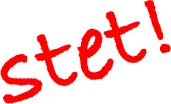Not usually the problem.
From about August 10 until just the other day, I was working on a book revision. It’s my third pass at this software manual that’s now distributed in ebook form. I’m not sure if I’m allowed to mention what it’s for, so I won’t. It doesn’t really matter, does it?
This book was unusual in that for the first time, it was the technical editors that gave me headaches. (Usually, it’s heavy-handed copyeditors.) My publisher waited until the last minute to contract me and everyone else who worked on the book and, because of that, they had trouble getting a good technical editor. They wound up with two people who apparently have nothing better to do than hang out in the support forums for the software and quite possibly hang on every word posted there. The first one worked on Chapters 2-14 before going on vacation. The other one worked on the rest of the 23-chapter book.
The problem I had centered around their apparent misunderstanding of what their job was. The first one kept commenting to tell me to add every known technique for performing each task. I’d decided early on to stick to menu commands and shortcut keys whenever possible, but she kept telling me to add this toolbar button or that hidden dialog option. It got on my nerves until we told her to stop. The other thing she did was introduce obscure problems that people in the forums have, apparently expecting the book to cover them all.
The other tech editor also drew upon his forum experience, this time expecting me to include marketing material that would clarify information about the features so forum participants would have less to complain about. The book’s a straight how-to — technically, it’s the software manual — so addressing the issues of a handful of forum whiners (the worse kind) isn’t part of the program. But what really got me mad was that this second editor was apparently unable to follow the instructions as written and kept telling me that things didn’t work. I’d have to go back and follow the instructions to see where I’d screwed up. But every single time, the instructions worked exactly as I’d written them. This was a huge time suck.
To be fair, they each did have a few comments that were actually worth acting on. I made a handful of changes that improved the book. That’s what their job was — to help me improve the book. But they didn’t seem to understand what would make the book better. All they seemed to know was what would make the book longer.
What neither understood is that I had about 15 days to revise a 600-page book. That’s not enough time to rewrite the book. All I had to do was add or change material for new or changed features. There weren’t many changes. The book, which was originally written by the software developer’s staff, had very few tech edit comments in the two previous editions I worked on. So I couldn’t figure out why these two editors kept coming up with comments that no one else had.
It’s the damn forums, I guess.




 Editing for the Sake of Editing
Editing for the Sake of Editing